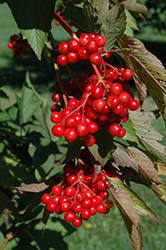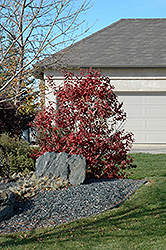Hahs American Cranberry
Viburnum trilobum 'Hahs'
Height: 12 feet
Spread: 10 feet
Sunlight:
![]()
![]()
Hardiness Zone: 2
Other Names: American Cranberrybush
Description:
A very attractive garden detail shrub which is covered in clusters of pure white pinwheel flowers in spring; bright red fruit is great for jams and jellies; hardy and adaptable, makes a great natural barrier
Ornamental Features
Hahs American Cranberry features showy white lacecap flowers held atop the branches in mid spring. It features an abundance of magnificent scarlet berries from late summer to late winter. It has dark green deciduous foliage which emerges coppery-bronze in spring. The serrated lobed leaves turn an outstanding purple in the fall. The smooth gray bark and gold branches add an interesting dimension to the landscape.
This plant is primarily grown as an ornamental, but it's also valued for its edible qualities. The small round sour berries are most often used in the following ways:
- Preserves
Landscape Attributes
Hahs American Cranberry is a dense multi-stemmed deciduous shrub with an upright spreading habit of growth. Its average texture blends into the landscape, but can be balanced by one or two finer or coarser trees or shrubs for an effective composition.
This is a relatively low maintenance shrub, and should only be pruned after flowering to avoid removing any of the current season's flowers. It is a good choice for attracting birds to your yard, but is not particularly attractive to deer who tend to leave it alone in favor of tastier treats. It has no significant negative characteristics.
Hahs American Cranberry is recommended for the following landscape applications;
- Accent
- Mass Planting
- Hedges/Screening
- General Garden Use
- Orchard/Edible Landscaping
Planting & Growing
Hahs American Cranberry will grow to be about 12 feet tall at maturity, with a spread of 10 feet. It tends to be a little leggy, with a typical clearance of 3 feet from the ground, and is suitable for planting under power lines. It grows at a medium rate, and under ideal conditions can be expected to live for 40 years or more.
This shrub does best in full sun to partial shade. It prefers to grow in average to moist conditions, and shouldn't be allowed to dry out. It is not particular as to soil type or pH. It is highly tolerant of urban pollution and will even thrive in inner city environments. This is a selection of a native North American species.

